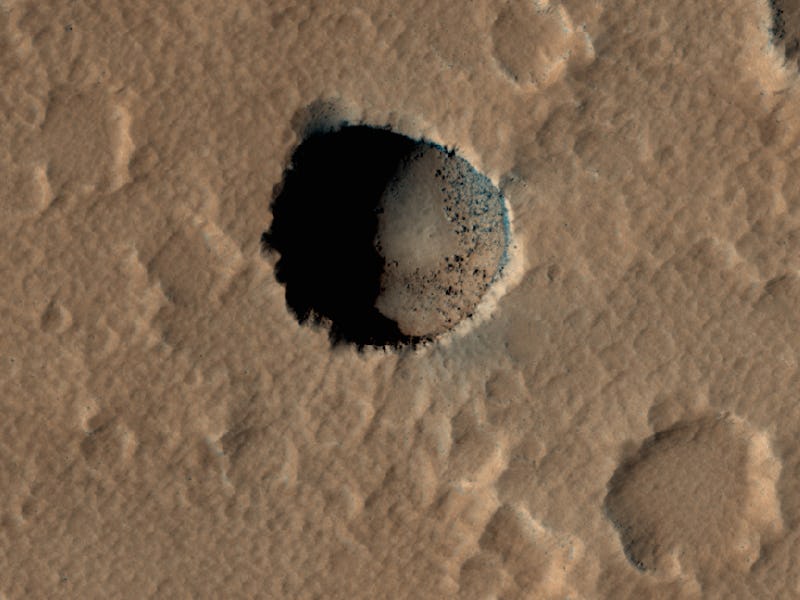This Pit Could Be "the Last Best Place" to Look for Life on Mars
Martian caves matter.

Earlier this month, NASA spotted a deep circular pit in the Martian south pole, a subterranean feature that some astrobiologists believe could have once harbored life — or might even do so today.
The Martian surface is a ruthless, uninviting place for life. Its surface is incessantly pummeled with life-destroying radiation — a double whammy of harmful rays from both our sun and deadly pulses from the greater universe. And on summer nights, the planet’s temperature still dips well below -100 degrees Fahrenheit. But the Martian underworld might provide a safe haven for microbial life to flourish, perhaps as slimy colonies on cave walls, just like those on Earth.
Dr. Penny Boston, director of NASA’s Astrobiology Institute, thinks that the Martian underworld is “the last best place” to look for potential life on Mars — an idea she first proposed in 1992.
NASA released this image on June 2, 2017. The deep impact crater on the right could either be a collapsed pit or an impact crater, according to NASA. The swiss cheese-like stuff is carbon dioxide ice.
Back then, there was scant evidence for this idea, but today NASA’s Mars Reconnaissance Orbiter zips around the red planet every 112 minutes, capturing rich images of dried-up Martian gullies, volcanoes, and craters. In the last 20 years, orbiting satellites have revealed 300 clearly identifiable subsurface features on Mars, like lava tubes and pit craters, Boston told Carlsbad Caverns National Park.
Life on Earth flourishes in caves, so Boston thinks that microbial life could certainly do so in the Martian underworld, shielded from the deadly radiated surface. Boston has repeatedly plunged into caves in the name of science, specifically Lechuguilla Cave in Carlsbad Caverns National Park. Here, she has found the cave walls teaming with incalculable species of microbes.
“The biodiversity down there is extreme — it’s super biodiverse,” said Boston. “One patch of bacteria in Lechuguilla might have just a 20 percent overlap with the patch next to it.”
The moon's surface is also replete with subterranean features, like this pit crater. NASA astrobiologist Penny Boston also believes that life could potentially live here -- a destination far closer than Mars.
Although NASA’s robots have been scouring the Martian surface for decades, digging into the soil and zapping rocks with lasers, the space agency has yet to find any compelling biosignatures — unambiguous evidence of past life, like a well-ordered chain of lipids from a cell wall. This lack of success may be a boon for Boston’s assertion that we should take a look into the Martian underworld.
Peering into the curious pits and craters, however, probably requires agile humans. The Martian rovers, like Curiosity, are immensely valuable extraterrestrial explorers, but they can’t possibly see what might exist deep inside these dark Martian pits.
NASA plans to send actual humans to Mars sometime in the 2030s. Let’s hope they like spelunking.